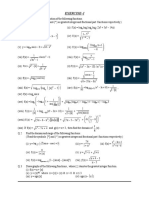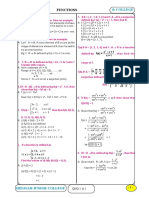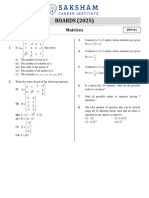Functions
Uploaded by
daudos2017Functions
Uploaded by
daudos2017ASSIGNMENT
Q1.
(a) Find the value of f(11)
...........................................................
(1)
(b) State which value of x must be excluded from any domain of f
...........................................................
(1)
–1
(c) Find f (x)
...........................................................
(3)
(d) State the value which cannot be in any range of f
...........................................................
(1)
(Total for question = 6 marks)
Q2.
The function f is such that f (x) =
(a) Find f(–2)
...........................................................
(1)
The function g is such that g (x) =
(b) Find g–1(6)
...........................................................
(2)
(c) Find fg(–5)
...........................................................
(2)
(d) Solve the equation f(x) = g (x)
Show clear algebraic working.
...........................................................
(4)
(Total for question = 9 marks)
Q3.
(a) Express the composite function gf in the form gf:x → ...
Give your answer as simply as possible.
gf:x → ...........................................................
(2)
(b) Express the inverse function g−1 in the form g−1:x → ...
g−1:x → ...........................................................
(3)
(Total for question = 5 marks)
Q4.
(a) Express the inverse function f−1 in the form f−1(x) = ...
f−1(x) = ...........................................................
(3)
(b) Solve fg(a) = 1
Show clear algebraic working.
a = ...........................................................
(3)
(Total for question = 6 marks)
Q5. f is a function such that
f(x) =
(a) Find f(1/2)
...........................................................
(1)
g is a function such that
g(x) = x≥1
(b) Find fg(x)
Give your answer as simply as possible.
fg(x) =...........................................................
(2)
(Total for question = 3 marks)
Q6.
The function f is defined as
(a) Find f (8)
...............................
(1)
(b) Express the inverse function f −1 in the form f −1(x) = ...
f −1(x) =..............................................
(2)
The function g is defined as
(c) Which values of x cannot be included in a domain of g?
..............................................
(2)
(d) Express the function gf in the form gf (x) = ...
Give your answer as simply as possible.
gf(x) =..............................................
(2)
(Total for question = 7 marks)
Q7. The functions g and h are such that
(a) What value of x must be excluded from any domain of g?
...........................................................
(1)
(b) Solve gh(x) = 1
...........................................................
(3)
(Total for question = 4 marks)
Q8.
f is the function such that f(x) = 4 – 3x
(a) Work out f(5)
(1)
g is the function such that
(b) Find the value of x that cannot be included in any domain of g
(1)
(c) Work out fg(−1.5)
(2)
(Total for question = 4 marks)
Q9.
The functions f and g are such that
(a) State the value of x that cannot be included in any domain of g
...........................................................
(1)
(b) Find gf(x)
Simplify your answer.
gf(x) = ...........................................................
(2)
(c) Express the inverse function g−1 in the form g−1(x) = ...
g−1(x) = ...........................................................
(3)
(Total for question = 6 marks)
Q10.
The function f is defined as
(a) Find f(10)
...........................................................
(1)
(b) Express the inverse function f–1 in the form f–1 : x→ ...
f–1 : x→ ...........................................................
(3)
(Total for question = 4 marks)
Q11.
The function f is such that
...........................................................
(1)
(b) Find f–1(x)
f –1(x) = ...........................................................
(2)
The function g is such that
g(x) = 5x2 – 20x + 23
(c) Express g(x) in the form a(x – b)2 + c
...........................................................
(3)
(Total for question = 6 marks)
Q12.
(a) Express the inverse function f−1 in the form f−1(x) = ...
f−1(x) =...........................................................
(2)
(b) Find gf(x)
Simplify your answer.
gf(x) =...........................................................
(2)
(Total for question = 4 marks)
Q13.
f is the function such that
(a) Find f(0.5)
...........................................................
(1)
(b) Find ff(–1)
...........................................................
(2)
(c) Find the value of x that cannot be included in any domain of f
...........................................................
(1)
(d) Express the inverse function f –1 in the form f –1(x) = ...
Show clear algebraic working.
f –1(x) = ...........................................................
(3)
(Total for question = 7 marks)
Q14.
The functions g and h are defined as
(a) Find the value of g(1)
...........................................................
(1)
(b) State which value of x must be excluded from any domain of g
...........................................................
(1)
(c) Find gh(x)
Simplify your answer.
gh(x) =...........................................................
(2)
(d) Express the inverse function g−1 in the form g−1(x) =...
g−1(x) =...........................................................
(3)
(Total for question = 7 marks)
Q15.
f is the function f(x) = 2x + 5
(a) Find f(3)
...........................................................
(1)
(b) Express the inverse function f−1 in the form f−1(x) =
f−1(x) = ...........................................................
(2)
g is the function g(x) = x2 − 25
(c) Find g(−3)
...........................................................
(1)
(d) (i) Find gf(x)
Give your answer as simply as possible.
gf(x) = ...........................................................
(ii) Solve gf(x) = 0
...........................................................
(5)
(Total for Question is 9 marks)
Q16.
The functions f and g are such that f(x) = x + 3 and g(x) =
(a) Find fg(x)
Give your answer as a single algebraic fraction expressed as simply as possible.
...........................................................
(3)
(b) Express the inverse function g−1 in the form g−1(x) = ...
g−1(x) = ...........................................................
(3)
(Total for Question is 6 marks)
Q17.
The functions f and g are defined as
(a) Work out f(6)
...........................................................
(1)
(b) Work out fg(−3)
...........................................................
(2)
(c) g(a) = −2
Work out the value of a.
a = ...........................................................
(2)
(d) Express the inverse function f−1 in the form f −1(x) = ...
f−1(x) = ...........................................................
(3)
(Total for Question is 8 marks)
Q18.
The function f is defined as
(a) Find the value of f(1)
...........................................................
(1)
(b) State which value of x must be excluded from any domain of f.
...........................................................
(1)
The function g is defined as g(x) = 5 + x
(c) Given that g(a) = 7, find the value of a.
a = ...........................................................
(1)
(d) Calculate fg(1)
...........................................................
(2)
(e) Find fg(x)
Simplify your answer.
fg(x) = ...........................................................
(2)
(Total for Question is 7 marks)
Q19.
(a) State which value of x cannot be included in the domain of f or g.
...........................................................
(1)
(b) Solve gf(a) = 3
a = ...........................................................
(3)
(c) Express the inverse function g−1 in the form g−1(x)
g−1(x) = ...........................................................
(3)
(Total for question = 7 marks)
You might also like
- GED Math Lessons Practice Problems Workbook (PDFDrive)100% (1)GED Math Lessons Practice Problems Workbook (PDFDrive)357 pages
- COMOSITE AND INVERSE FUNCTIONS Worksheet IB Maths AA SLNo ratings yetCOMOSITE AND INVERSE FUNCTIONS Worksheet IB Maths AA SL7 pages
- Free Access to Test Bank for Calculus for Business, Economics, Social & Life Sciences, 11th Edition: Laurence D. Hoffmann Chapter Answers100% (11)Free Access to Test Bank for Calculus for Business, Economics, Social & Life Sciences, 11th Edition: Laurence D. Hoffmann Chapter Answers48 pages
- Mathematics 1a Vsaq's Hidayah Junior College PDFNo ratings yetMathematics 1a Vsaq's Hidayah Junior College PDF28 pages
- 1.1 Functions Topic Questions 0606 Set 2 QP MsNo ratings yet1.1 Functions Topic Questions 0606 Set 2 QP Ms14 pages
- Free Access to Test Bank for Calculus for Business, Economics, Social & Life Sciences, 11th Edition: Laurence D. Hoffmann Chapter Answers100% (12)Free Access to Test Bank for Calculus for Business, Economics, Social & Life Sciences, 11th Edition: Laurence D. Hoffmann Chapter Answers60 pages
- Instant Download for Test Bank for Calculus for Business, Economics, Social & Life Sciences, 11th Edition: Laurence D. Hoffmann 2024 Full Chapters in PDFNo ratings yetInstant Download for Test Bank for Calculus for Business, Economics, Social & Life Sciences, 11th Edition: Laurence D. Hoffmann 2024 Full Chapters in PDF61 pages
- To Learn, To Serve, To Lead: Thiruvattar, Kanyakumari DistrictNo ratings yetTo Learn, To Serve, To Lead: Thiruvattar, Kanyakumari District5 pages
- [Math-AA 2.4-2.5] COMPOSITION - INVERSE FUNCTION_ecoNo ratings yet[Math-AA 2.4-2.5] COMPOSITION - INVERSE FUNCTION_eco11 pages
- Tai Kwong Hilary College Assignment For WEEK 27 (Semester 2) Grade 10No ratings yetTai Kwong Hilary College Assignment For WEEK 27 (Semester 2) Grade 105 pages
- Problems Proposed by Vasc and Arqady - Edited by Sayan MukherjeeNo ratings yetProblems Proposed by Vasc and Arqady - Edited by Sayan Mukherjee13 pages
- Ap Calculus Ab Winter Term Quiz Three Name Answer Key: F X F FNo ratings yetAp Calculus Ab Winter Term Quiz Three Name Answer Key: F X F F4 pages
- Normal Forms and Bifurcation of Planar Vector Fields 1st Edition Shui-Nee Chow - The ebook in PDF format with all chapters is ready for download100% (1)Normal Forms and Bifurcation of Planar Vector Fields 1st Edition Shui-Nee Chow - The ebook in PDF format with all chapters is ready for download47 pages
- C2 Algebra - Remainder and Factor TheoremNo ratings yetC2 Algebra - Remainder and Factor Theorem37 pages
- Project in Mathematics: by JM C. VillanuevaNo ratings yetProject in Mathematics: by JM C. Villanueva10 pages
- Numerical Methods For Engineers: (6th Edition)No ratings yetNumerical Methods For Engineers: (6th Edition)5 pages
- 84 Vector and Parametric Equations of A PlaneNo ratings yet84 Vector and Parametric Equations of A Plane2 pages
- Delhi Public School Bangalore - East MathematicsNo ratings yetDelhi Public School Bangalore - East Mathematics5 pages
- Part I: Numerical Solution For Single Variable: 1.1. Newton-Raphson MethodNo ratings yetPart I: Numerical Solution For Single Variable: 1.1. Newton-Raphson Method9 pages
- Grade 10 Daily Lesson Log School Grade Level 10 Teacher Learning Area Mathematics Quarter FirstNo ratings yetGrade 10 Daily Lesson Log School Grade Level 10 Teacher Learning Area Mathematics Quarter First14 pages
- The Story of Fermat's Last Theorem (Akanksha)No ratings yetThe Story of Fermat's Last Theorem (Akanksha)10 pages
- Veilahti, A., Alain Badiou's Mistake - Two Postulates of Dialectical Materialism PDFNo ratings yetVeilahti, A., Alain Badiou's Mistake - Two Postulates of Dialectical Materialism PDF54 pages
- 10 Math 3rdgrading Divide Numbers FoundNo ratings yet10 Math 3rdgrading Divide Numbers Found27 pages
- Number Theory - DPP 04 (Extra) - IOQM Booster Batch 2024No ratings yetNumber Theory - DPP 04 (Extra) - IOQM Booster Batch 20243 pages
- GED Math Lessons Practice Problems Workbook (PDFDrive)GED Math Lessons Practice Problems Workbook (PDFDrive)
- COMOSITE AND INVERSE FUNCTIONS Worksheet IB Maths AA SLCOMOSITE AND INVERSE FUNCTIONS Worksheet IB Maths AA SL
- Free Access to Test Bank for Calculus for Business, Economics, Social & Life Sciences, 11th Edition: Laurence D. Hoffmann Chapter AnswersFree Access to Test Bank for Calculus for Business, Economics, Social & Life Sciences, 11th Edition: Laurence D. Hoffmann Chapter Answers
- Free Access to Test Bank for Calculus for Business, Economics, Social & Life Sciences, 11th Edition: Laurence D. Hoffmann Chapter AnswersFree Access to Test Bank for Calculus for Business, Economics, Social & Life Sciences, 11th Edition: Laurence D. Hoffmann Chapter Answers
- Instant Download for Test Bank for Calculus for Business, Economics, Social & Life Sciences, 11th Edition: Laurence D. Hoffmann 2024 Full Chapters in PDFInstant Download for Test Bank for Calculus for Business, Economics, Social & Life Sciences, 11th Edition: Laurence D. Hoffmann 2024 Full Chapters in PDF
- To Learn, To Serve, To Lead: Thiruvattar, Kanyakumari DistrictTo Learn, To Serve, To Lead: Thiruvattar, Kanyakumari District
- [Math-AA 2.4-2.5] COMPOSITION - INVERSE FUNCTION_eco[Math-AA 2.4-2.5] COMPOSITION - INVERSE FUNCTION_eco
- Tai Kwong Hilary College Assignment For WEEK 27 (Semester 2) Grade 10Tai Kwong Hilary College Assignment For WEEK 27 (Semester 2) Grade 10
- Problems Proposed by Vasc and Arqady - Edited by Sayan MukherjeeProblems Proposed by Vasc and Arqady - Edited by Sayan Mukherjee
- Ap Calculus Ab Winter Term Quiz Three Name Answer Key: F X F FAp Calculus Ab Winter Term Quiz Three Name Answer Key: F X F F
- Normal Forms and Bifurcation of Planar Vector Fields 1st Edition Shui-Nee Chow - The ebook in PDF format with all chapters is ready for downloadNormal Forms and Bifurcation of Planar Vector Fields 1st Edition Shui-Nee Chow - The ebook in PDF format with all chapters is ready for download
- Part I: Numerical Solution For Single Variable: 1.1. Newton-Raphson MethodPart I: Numerical Solution For Single Variable: 1.1. Newton-Raphson Method
- Grade 10 Daily Lesson Log School Grade Level 10 Teacher Learning Area Mathematics Quarter FirstGrade 10 Daily Lesson Log School Grade Level 10 Teacher Learning Area Mathematics Quarter First
- Veilahti, A., Alain Badiou's Mistake - Two Postulates of Dialectical Materialism PDFVeilahti, A., Alain Badiou's Mistake - Two Postulates of Dialectical Materialism PDF
- Number Theory - DPP 04 (Extra) - IOQM Booster Batch 2024Number Theory - DPP 04 (Extra) - IOQM Booster Batch 2024

























































































